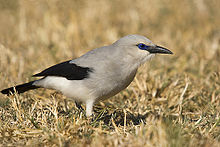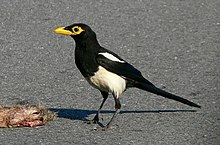Real magpies
| Real magpies | ||||||||||||
|---|---|---|---|---|---|---|---|---|---|---|---|---|

Hudson's Elster ( Pica hudsonia ) |
||||||||||||
| Systematics | ||||||||||||
|
||||||||||||
| Scientific name | ||||||||||||
| Pica | ||||||||||||
| Brisson , 1760 |
The Real magpies ( Pica ) constitute a genus from the family of the crows (Corvidae). They have long, tiered tails and black and white basic colors with an iridescent blue-green sheen. The range of the genus includes the temperate North Africa , Eurasia and North America . Like most corvids, the food of the real magpies is very diverse and is usually taken up by them on the ground.
features
Real magpies are slender, medium-sized corvids with characteristic plumage. The largest representative of the genus is the magpie subspecies P. pica bottanensis from the western Himalayas. It reaches a wing length of 244-265 mm. The smallest real magpie is the yellow-billed magpie ( P. nuttalli ) with a wing length of 173–196 mm. All species show a very homogeneous appearance with almost the same color and proportions. The bill and legs are black in almost all species. Only the yellow-billed elster falls out of the ordinary with its yellow beak and the same-colored rear eye spot.
Systematics
External system

The real magpies belong within the corvids to a group of genera that originated in the ancient world . Their closest relatives are two monotypic genera from northern Africa, the Stresemann's Bushcrow ( Zavattariornis ) and the Piapias ( Ptilostomus ) and wüstenbewohnenden Saxaulhäher ( Podoces ). The magpies are basal in this clade and are more tied to temperate, tree-rich areas, while the younger genera have increasingly adapted to warm, dry habitats with sparse vegetation.
| remaining corvids |
|
||||||||||||||||||
|
|
Internal system


The physical resemblance of the Real magpies among themselves meant that except for the yellow-billed magpie ( P. nuttalli ) all forms long time as a subspecies of Palearctic Elster ( P. pica were considered). On the basis of similarities in behavior and physique with the yellow-billed elster, the Hudson's elster ( P. hudsonia ) was raised to the status of a species, as it would be less closely related to the magpie than assumed. Analyzes of the mitochondrial DNA also showed that the Korean magpie ( P. sericea ) from eastern China and the lower Amur region is basal in the genus, i.e. is less closely related to the other species than they are to each other. An extinct island form of the real magpies existed with Pica mourerae on Mallorca at least until the early Pleistocene . Its systematic position has not yet been clarified, but the geographical proximity to the Elster suggests a close relationship.
| Real Magpies ( Pica ) |
|
||||||||||||||||||
|
|
The genetic difference between the Korean magpie and the remaining genus probably results from a geographical isolation of the two species, which existed in the late Pliocene . This could have been tectonic and volcanic activity that prevented an exchange between Korean and Chinese populations. The black-billed and yellow-billed magpie probably descend from a common ancestor who penetrated the Bering Strait into North America and was isolated there by the glaciers of the Rocky Mountains in two different areas during one of the last ice ages . This eventually led to the two species that exist today. The radiation (fanning out) within the real magpies took place in a very short time. All current lines of development separated from each other in the middle Pleistocene . Since the real magpies are very closely related to one another, they could also be summarized in conservative taxonomic concepts to form a kind of pica pica . This contrasts with behavioral differences between Old and New World species and so far missing reports on hybrids .
literature
- Steven D. Emslie: Avian Community, Climate, and Sea-Level Changes in the Plio-Pleistocene of the Florida Peninsula. In: Ornithological Monographs 50, 1998. pp. 1-113.
- Per GP Ericson, Anna-Lee Jansen, Ulf S. Johansson, Jan Ekman: Inter-generic Relationships of the Crows, Jays, Magpies and Allied Groups (Aves: Corvidae) Based on Nucleotide Sequence Data . In: Journal of Avian Biology 36, 2005. pp. 222-234.
- Sang-im Lee, Cynthia S. Parr, Youna Hwang, David P. Mindell, Jae C. Choea: Phylogeny of magpies (genus Pica) inferred from mtDNA data . In: Molecular Phylogenetics and Evolution 29, 2003. doi: 10.1016 / s1055-7903 (03) 00096-4 , pp. 250-257.
- Steve Madge , Hilary Burn: Crows & Jays. Princeton University Press, Princeton 1994, ISBN 0-691-08883-7 .
- Bartomeu Seguí: A new species of Pica (Aves: Corvidae) from the Plio-Pleistocene of Mallorca, Balearic Islands (Western Mediterranean) . In: Geobios 34 (3). Pp. 339-347.
Web links
- Walt Koenig, Matt Reynolds: Yellow-billed Magpie (Pica nuttalli) . In: A. Poole: The Birds of North America Online . Cornell Lab of Ornithology, Ithaca 2009. doi: 10.2173 / bna.389
Individual evidence
- ^ Koenig & Reynolds 2009 . Retrieved October 11, 2011.
- ↑ Madge & Burn 1994 , pp. 120-122.
- ↑ Ericson et al. 2005 , pp. 232-233.
- ↑ a b Lee et a. 2003 , p. 255.
- ↑ Seguí 2001 , pp. 345–346.
- ↑ Lee et al. 2003 , p. 256.